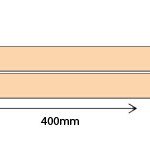One of the major advantages of a stud wall is the fact that they are hollow. This makes them extremely handy for hiding pipes, wires, and other services. The hollow space between studs, also provides a really useful space to add insulation. This can be done without taking up any additional space.

If you are building a new stud wall from scratch, then adding insulation is recommended. However, there is no regulation that says you have too. Therefore, you can build a stud wall without insulation if you want. However, this will cause the wall to be far less efficient.
As well as insulating, there are also have several other benefits to adding insulation to a stud wall. Below we will look at some of the main advantages.
Advantages of insulating a stud wall
The main advantage of insulating a stud wall, is obviously insulation. It provides a thermal barrier which stops heat from escaping the room. Whilst standard plasterboard does provide some level of insulation, it is far less than a stud wall with added insulation.
Below are some of the other benefits you will get from adding insulation to a stud wall:
- Lower energy bills – This can be quite significant, especially with rising energy costs. A fully insulated room can maintain temperature for a long time. Often, this means your heating is on for a small amount of time and then you can turn it off.
With a stud wall that is missing insulation, this heat will be lost much quicker. You may even find the heating is left on for long periods to maintain the temperature. - Sound proofing – Adding something like rockwool or solid sheet insulation, will reduce noise transfer between rooms. According to building regulation, sound reduction is a requirement in some cases. For example, any walls that separate a bedroom from other rooms. As well as bathrooms.
This can be achieved in two main ways. The first is to double up the plasterboards. Meaning, you would have 2 x 12.5mm plasterboards, on each side of your wall. The other option is to add insulation. Obviously, adding the insulation, provides many more benefits, so it is arguably the best choice. - Added fire protection – A standard stud wall using 12.5mm plasterboard has a fire resistance of around 30 minutes. This meets building regulations for most residential applications.
Insulation is non-combustible, and therefore does not add fuel to the fire. Also sheet insulation, such as Kingspan tend to char. This slows the rate at which fire passes through the wall. You can see a video demonstration of this below.
Types of insulation for stud walls
There are two main types of insulation used in stud walls:
- Mineral wool quilt, such as rockwool
- Sheet insulation, such as Kingspan.
Both provide similar levels of insulation. The one you choose, will depend on several factors. Firstly, both need to be fitted correctly, if they aren’t, you will lose the benefit.
Kingspan is slightly more expensive. However it is nicer to work with, and providing it is fitted correctly, it will provide great insulation, as well as slightly better fire protection.
It is important to point out, the insulation sheet needs to be cut tight into your studwork. This can require a certain level of skill, and if done badly (lots of gaps), this will affect the overall thermal qualities.
Mineral wool’s are cheaper, and they are a little easier to fit. Most brands come in 1200mm rolls. The rolls usually have a partial cut at 400mm and 600mm. This means you can easily separate the material to the correct width, allowing it to fit comfortably between your studs (usually just under 400mm).
The main disadvantage with this insulation in my opinion, is its itchy. Anyone who has worked with rockwool will tell you this. It also does have the potential to slide down if fitted loosely. This can be remedied with a couple of well-placed screws.
Basically, the type you choose is up to you.
As someone who has used both, I would probably choose sheet insulation if it was a small job. The extra cost would probably be worth it in my opinion. Also, if I wasn’t paying for it, I would always prefer something like Kingspan (or a cheaper alternative).
If it was a big job and the price difference was significant, I would probably opt for rockwool, just because its cheaper. If there was a big difference in price, the slight discomfort of rockwool would probably be worth it.
Basically you just have to weigh up the pros and cons. The finished result for both will be very similar. Both will provide a great level of insulation.
Conclusion
You don’t need to insulate a stud wall. However, this doesn’t mean you shouldn’t. Yes, there is an extra job to do, and there will be some extra expense. But, at the same time, there are several benefits you will gain from insulating your stud wall.
Not wanting to spend the extra money is a false economy, the amount you save in energy alone, will far outweigh the insulation price over time.
It will also dramatically reduce noise coming from other areas of your property.
And finally, it will add a small increase to your walls fire resistance. This might only be a small increase, but it will give you and your family more time in the event of a fire.




